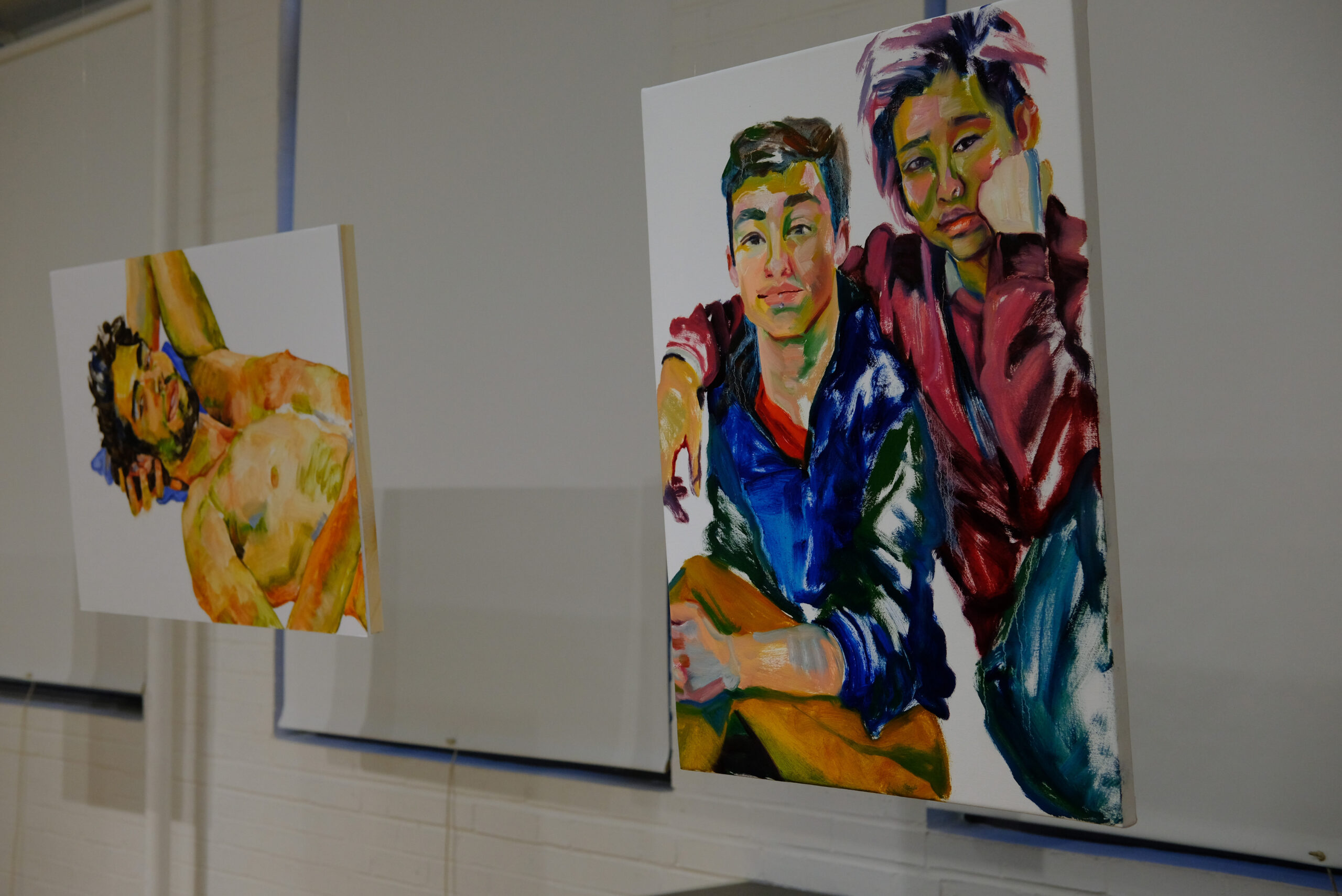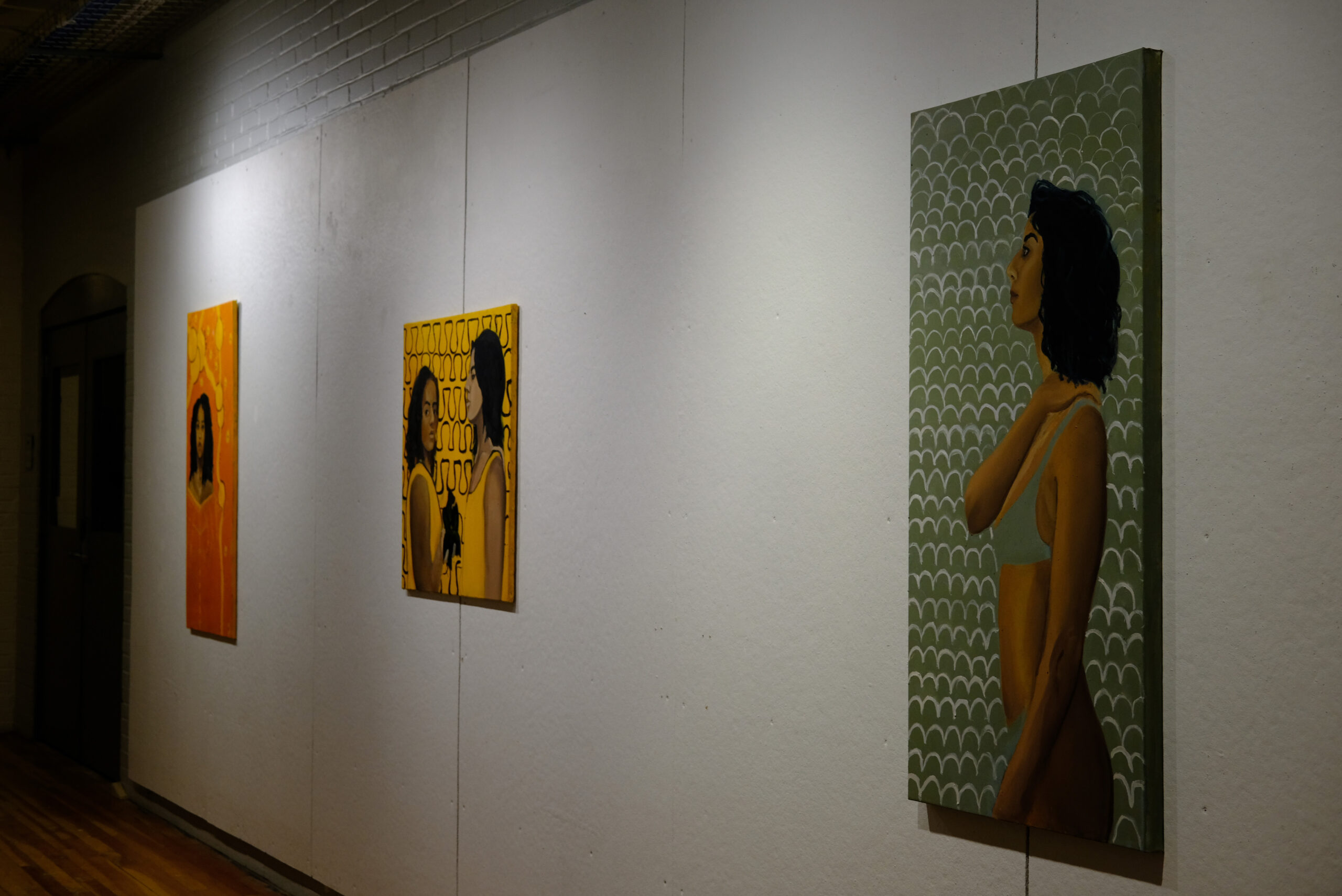Senior art show inspires with creative experimentation
April 24, 2019
 Devaki Rajiv
Devaki RajivFrom monumental murals in neon colors to life castings molded out of earth and clay, this year’s senior art show dazzles the eye and excites the mind. On Wednesday night, the exhibition titled “Changeover” transformed the Edwards Center for Art and Dance into an active ground of artistic vision and reflection.
This annual show is the culmination of a semester of independent work from the Advanced Studio class, taught by Mark Wethli, the A. LeRoy Greason professor of art, and includes pieces from seven students: Evelyn Beliveau ’19, Charlotte Borden ’19, Caroline Dranow ’20, Camille Farradas ’19, Blanche Froelich ’19, Amber Orosco ’19 and Darius Riley ’19. Ranging drastically in their choice of media, style and inspirations, the artists offer an eclectic look into Bowdoin’s creative side.
Though the show’s title—“Changeover”—was a group decision, the artists said that their processes in the studio as well as the final exhibition have been highly independent in nature. Each component marks a mini-capstone that illustrates or comments on their artistic evolution over the past four years.
“The show really wasn’t conceptualized as a themed show,” said Froelich. “All seven people involved in the show are coming from their own perspectives, their own backgrounds, their own bodies of work … I think for the artists, ‘Changeover’ really is a word that is meant to signify transition, change and turning points.”
As visitors roam through different spaces in Edwards, the artists’ distinct styles and unique personalities stand out as the show’s unmistakable highlight. This can be attributed to the format of the class, which, as the most advanced visual arts course offered at Bowdoin, allows each artist to carry out individual projects in a variety of mediums including painting, photography and installation. The classroom becomes an arena for experimentation.
Orosco, for example, created an installation out of plastic, paint and paper that explores movement and materiality. Yet she appreciates co-existing alongside her peers who are working in completely opposite idioms and cites this dynamic juxtaposition as a source of inspiration.
“I work in such a variety of mediums, [and] it’s so refreshing to look over and see someone just drilling this very beautiful medium of oil painting,” Orosco said. “I work in pretty monochrome [colors] or stick to grayscale, and across the room is Camille, and she works in highlighter colors and the most beautiful, vibrant colors.”
Additionally, many of the students have been taking art classes together since their first year at Bowdoin, creating a camaraderie that makes the studio experience particularly gratifying. The group has bonded over weekly critiques, late nights in Edwards and an art-focused field trip to New York City.
“We talk all the time,” Beliveau said. “I love being able to poke my head into people’s studios. I feel like a lot of ideas, even if we’re not really aware of it, have been kind of cross-pollinating, which I love.”
Despite the lack of intentional thematization, this cross-pollination of ideas seems to have drawn out an implicit connection or dialogue among all the artworks. The space is fluid, as are the artists’ choices of subject and sources of inspiration. Many pieces engage with the larger art historical tradition of the figure, the embodied experience and human interactions at large.
“Darius did a lot with the human condition and what it means to be human in this world. Caroline does a ton of figurative work as well. Amber does more installation, but even she explores how the body impacts that material, impacts that space and how it can interact with that [in art] … I think definitely there’s a common theme between a lot of our work,” Farradas said.
The show has also allowed artists to be more introspective and contemplative in their process; Farradas derived iconography from her religion and personal notions of spirituality, while Dranow paid an intimate tribute to women on campus who enrich her life. Riley, who has previously used art in more overtly activist contexts, is now speaking to a larger, universal truth.
“I wanted to do something like this, something that kind of stood out from identity and a recognizable face or figure, a person,” Riley said. “My work used to sometimes feel didactic in this space … [Now] the art gets to speak for itself.”
For graduating seniors, this show is a bittersweet farewell to a defining chapter in their creative careers. But “Changeover” also provides a vision of what is to come, a moment of uncertainty as well as new promises.
“[Professor Wethli has showed us] how the idea of establishing a routine practice of art is habitual, and it’s also a lifelong experience—so this is just the beginning,” Dranow said.
“Changeover” will be on view at Edwards Center of Art and Dance until May 3.
Brianna Cunliffe and Julia Perillo contributed to this report.


Comments
Before submitting a comment, please review our comment policy. Some key points from the policy: